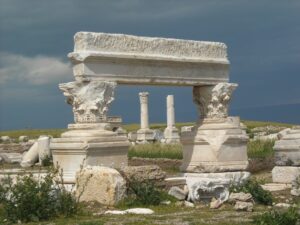Conclusion: In a very real sense, the church today is like the Philadelphian church, for God has set before us many open doors of opportunity. If He opens the doors, we must work; if He shuts the doors, we must wait. Above all, we must be faithful to Him and see the opportunities, not the obstacles. If we miss our opportunities, we lose our rewards (crowns), and this means being ashamed before Him when He comes (1 Jn.2:28). The letter to the faithful Philadelphia church reveals that the holy, omnipotent God pours out His blessings on churches that remain loyal to Him.
Laodicea : The Nauseating church (3:14-22)
Laodicea is the last and the worst church. The church was a totally unchanged, deceitful assembly for which Christ had nothing to say positive. The Lord Jesus Christ did not identify Himself using any of the phrases of the vision recorded in (1:12-17), but described as “Amen” which means ‘truth, affirmation or certainty.’ He is “Amen” because the “He is the God of truth incarnate, He is the one who confirmed all of God’s promises and He is the faithful and true witness” because “Jesus Christ is the way, the truth and the life”(Jn.14:6). The Lord also referred Himself as “the Beginning of the creation of God.” It does not mean that Christ was the first person God created, but rather that Christ Himself is the source of creation (Rev.22:13). This Church is a reflection of the churches in 1900 A.D to the Rapture of the Church.

Laodicea in ruins:
History: The Bible does not record anything about the founding of the Church at Laodicea. It was probably established during Paul’s ministry at Ephesus (Acts. 19:10), but Paul did not found it, since when he wrote Colossians some years later he still had not visited Laodicea (Col.2:1). Since Pauls co-worker Epaphras founded the church in nearby Colassae (Col. 1:6-7), he may well have founded the Laodicean church as well. Some people suggest that Archippus, Philemon’s son (Phil. 2) was its pastor (Col.4:17), since the 4th century Apostolic Constitutions names Archippus as the bishop of Laodicea.
Laodicea was the south-easternmost of the 7-cities, about 40-miles from Philadelphia. Its neighbouring cities were Colassae, Hierapolis. Laodicea was geographically nearly impenetrable. Its only vulnerability to attack was due to the fact that it had to pipe in its water from several miles away through aqueducts that could be easily be blocked or diverted by besieging forces. The city was founded by the Seleucid ruler Antiochus II and named after his first wife. There were significant number of Jews settled there. The local government once prohibited the Jews from sending the temple tax to Jerusalem. When they attempted to do so in spite of the prohibition, he confiscated the gold they intended for that tax. From the amount of the seized shipment, it has been calculated that 7500 Jewish men lived in Laodicea. The city was wealthy that is paid for its own reconstruction after a devastating earthquake in AD 60 rejecting the financial aid from Rome.
The city was famous for the soft, black wool it produced. The wool was made into clothes and women in carpets both highly valued. Laodicea was also an important centre of ancient medicine. The nearby temple of the Phrygian god Men Karou had an important medical school associated with it. That school was most famous for an eye salve that it had developed, which was exported all over the Greco Roman world. All three industries, finance, wool and the production of eye-salve come into play n this letter to the church of Laodicea.
Appreciation: There was no appreciation for this Nauseating church.